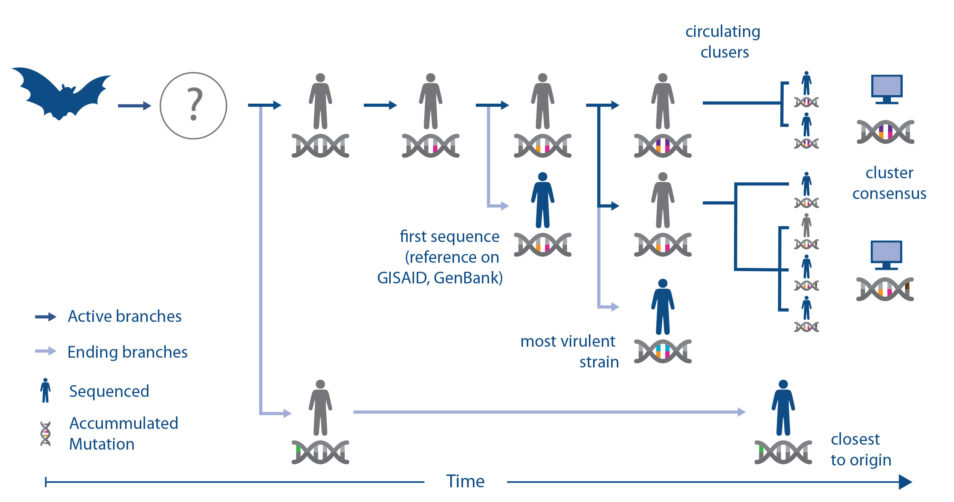Global S&T Development Trend Analysis Platform of Resources and Environment
| Genomics joins the fight against COVID-19 | |
| admin | |
| 2020-04-21 | |
| 发布年 | 2020 |
| 语种 | 英语 |
| 国家 | 澳大利亚 |
| 领域 | 地球科学 |
| 正文(英文) |
As the world faces the COVID-19 pandemic, it’s critical for us to understand the genetic make-up of this virus. We have been analysing global data on the genome sequence of the new coronavirus SARS-CoV–2 to fast track our understanding of the disease. The findings will help researchers around the world understand how strains of the virus evolve and identify new clusters of the virus. The genome of SARS-CoV-2 is not changing as rapidly as other RNA viruses like influenza. But we need to monitor changes in the virus that can potentially modify the way it causes harm to its hosts. This is important when developing and evaluating vaccines, therapeutics and diagnostic tests. Dr S.S. Vasan is leading our SARS-CoV-2 virus work and vaccine evaluation studies. “At this time, we do not expect it will affect the development and evaluation of COVID-19 vaccines, therapies and diagnostics. But it is important information to monitor as preclinical and clinical studies progress,” he said. Virus decoded with genomicsGenomics, or genome sequencing, is the process of figuring out all the information encoded in the structure of an organism. Coronaviruses are made up of RNA instead of DNA. This means they mutate and change quickly. These mutations make it hard to test which treatments might work against the virus. However, identifying the mutations – or differences – among the 30,000 letters of the viral genome is not an easy task.  Understanding genome sequences helps researchers choose the right strain of the virus for vaccine and diagnostic efforts. New software helps to select the most representative strainOur team has developed software that analyses the genetic codes – or the blueprint – of the virus. Our researcher Dr Denis Bauer said as the virus evolves, this blueprint becomes increasingly important. It holds instructions about the behaviour of the virus and what kind of disease it can cause. “The software developed by our team provides a visualisation showing the relationships between each strain of the virus. This helps to showcase information about the different strains of the virus. For example, where it came from and how well it might replicate,” Dr Bauer said. It’s critical to understand the distance between the original reference point of the virus and the newly emerging components. This helped us determine which strain to choose for pre-clinical testing. The right strain for selection should have a small genetic distance to all the newly emerging components. Analysing a significant amount of genome sequencing data in this way can help fast track our understanding of this complex disease. Dr S.S. Vasan said after studying SARS-CoV-2’s genome sequence, we have confirmed the virus is evolving into a number of distinct clusters in different parts of the world. “However, at this time we do not think it will affect the development and evaluation of COVID-19 vaccines, therapies and diagnostics. But we will continue to closely monitor the situation,” Dr Vasan said. Help us better understand the COVID-19 genetic codeThis work is just the tip of the information iceberg in understanding the COVID-19 virus. We are calling on the international research community to share de-identified clinical information about the disease progression alongside the genomic sequences of the virus. We need to be well informed about the genetic differences of the virus. This way we can understand the likely consequences on the progression of the disease. Then we can better tackle the disease with diagnostics and treatments. The peer-reviewed research paper, Supporting pandemic response using genomics and bioinformatics: a case study on the emergent SARS-CoV-2 outbreak, was accepted for publication by the Transboundary and Emerging Diseases journal on 7 April 2020. |
| URL | 查看原文 |
| 来源平台 | Commonwealth Scientific and Industrial Research Organisation |
| 文献类型 | 新闻 |
| 条目标识符 | http://119.78.100.173/C666/handle/2XK7JSWQ/273932 |
| 专题 | 地球科学 |
| 推荐引用方式 GB/T 7714 | admin. Genomics joins the fight against COVID-19. 2020. |
| 条目包含的文件 | 条目无相关文件。 | |||||
| 个性服务 |
| 推荐该条目 |
| 保存到收藏夹 |
| 查看访问统计 |
| 导出为Endnote文件 |
| 谷歌学术 |
| 谷歌学术中相似的文章 |
| [admin]的文章 |
| 百度学术 |
| 百度学术中相似的文章 |
| [admin]的文章 |
| 必应学术 |
| 必应学术中相似的文章 |
| [admin]的文章 |
| 相关权益政策 |
| 暂无数据 |
| 收藏/分享 |
除非特别说明,本系统中所有内容都受版权保护,并保留所有权利。
修改评论